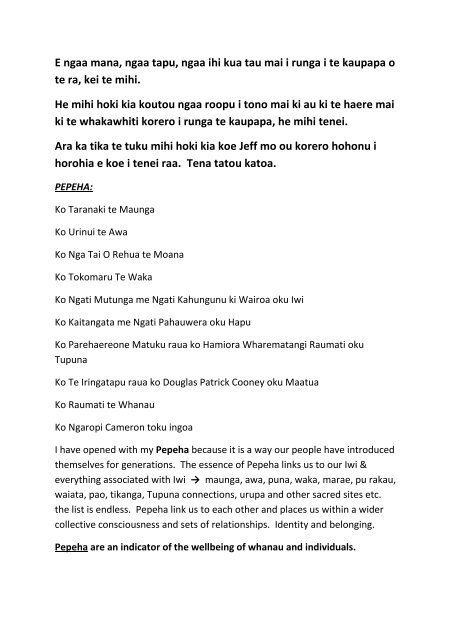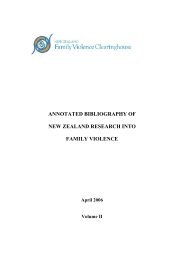E ngaa mana, ngaa tapu, ngaa ihi kua tau mai i runga i te kaupapa o ...
E ngaa mana, ngaa tapu, ngaa ihi kua tau mai i runga i te kaupapa o ...
E ngaa mana, ngaa tapu, ngaa ihi kua tau mai i runga i te kaupapa o ...
Create successful ePaper yourself
Turn your PDF publications into a flip-book with our unique Google optimized e-Paper software.
Ma<strong>te</strong> koe I <strong>te</strong> aroha, titiro ki Taranaki, hei purei kohu, ko matou kei raro ee. Apao composed by our kuia is used to access Tupuna knowledge and supportreorientation of women back to their true role as leaders within Te Ao Māori.(Same story, remnants of Tupuna knowledge is present and in some totallytraumatised and qui<strong>te</strong> seda<strong>te</strong>d as well.) The pao is recapped each session,practiced and pepeha reci<strong>te</strong>d.I am going to show a few images that illustra<strong>te</strong> different values and aspectsof cultural constructs that support Māori de<strong>te</strong>rminants of whanau wellbeing.They are also designed to dispel the illusion that we didn’t have a writ<strong>te</strong>nlanguage and Kowhaiwhai pat<strong>te</strong>rns are woven into the images. A Te AoMāori snap shot.WHAKAPAPA: the Kowhaiwhai pat<strong>te</strong>rn used here to illustra<strong>te</strong> Whakapapa isMANGOPARE (Hammerhead shark) and it represents power and strength.Whakapapa is a tool for engagement, setting behavioural boundaries andsocial responsibilities. It informs one about being part of a culture belonging toa place, and the continuum of life that includes kinship, history, obligations andreciprocity. Tupuna and mokopuna are always present in whakapapa.Tupuna: Tu → upright, standing. Puna → pool of wa<strong>te</strong>r.Mokopuna: Moko → mark, marking. Puna → pool of wa<strong>te</strong>r. Mokopuna –bearing the mark of the upright standing pool of wa<strong>te</strong>r.This concept alone indica<strong>te</strong>s the sanctity of children. They are theembodiment of all past and future generations and as such to hurt, hit orabuse a child is to hurt, hit and abuse all past and future generations that linkto that child.Whakapapa underpins the essence of Maori identity.WAIRUA: this pat<strong>te</strong>rn is TUHORO ATEA and depicts the spiritual connectionbetween Ranginui and Papatuanuku.As whakapapa is a tool for engagement Wairua is the first level on which oneengages. Wairua is the core of Māori wellbeing.MANA: this pat<strong>te</strong>rn is TUHORO KAOKAO and is a dimension of Wairua.
Mana represents the re-establishment and re<strong>te</strong>ntion of self-respect. Mana isan expression of achievement, power and influence. All human beings are bornwith <strong>mana</strong> but only Māori have Mana Māori.Personal and group relationships are media<strong>te</strong>d and guided by the high valueplaced upon <strong>mana</strong>. To viola<strong>te</strong> the <strong>mana</strong> of the individual is to viola<strong>te</strong> the <strong>mana</strong>of the whole whanau, including your own inherent <strong>mana</strong>.Mana acts as a de<strong>te</strong>rrent to violent behaviour by encouraging the creation ofwellness behaviours as Acts of Mana → <strong>mana</strong> enhancing behaviour.TAPU: this pat<strong>te</strong>rn KOKOROMATUA RAE; another dimension of Wairua.Tapu emphasises the need to reclaim the divinity of children and sanctity ofwomen. All human beings are born <strong>tapu</strong> (sacred) and there are several aspectsto <strong>tapu</strong>. (Which I am not going to go into at this time)Personal and group relationships are media<strong>te</strong>d and guided by the high valueplaced upon <strong>tapu</strong>. To viola<strong>te</strong> the <strong>tapu</strong> of the individual is to viola<strong>te</strong> one’s own<strong>tapu</strong>. Pa Henare Ta<strong>te</strong> describes violence as an addiction to the violation of<strong>tapu</strong>.TIKANGA: this pat<strong>te</strong>rn is MAKAURANGI; it describes the compassion andempathy expressed by Ranginui towards Papatuanuku at their forcedseparation.Tikanga embraces correct and ethical behaviour and practice, also providingthe 1 st instant of accountability in relation to behaviour and attitude. Correctthought, correct attitude, correct behaviour, get it straight, be direct (don’twaffle).Tikanga is the 1 st law of Ao<strong>te</strong>aroa; which has been usurped by successivesettler governments and the criminal legal sys<strong>te</strong>m. (Mikaere, A) Tikanga wassuppor<strong>te</strong>d by <strong>mana</strong> and <strong>tapu</strong> to <strong>mai</strong>ntain social order. The denigration oftikanga has resul<strong>te</strong>d in unbalance in all things particularly on gender andwhanau relationships. ‘It falls on us to ‘remake’ gender balance as an act ofdecolonisation’. (Pihama, L, Cameron, N)
Balance is highly desirable because cultural survival requires balance andbalance implies an absence of dominance and subservience. (Mikaere, A)Balance supports a world view where all things in creation → ki <strong>runga</strong> above, kiraro below, ki roto within, ki waho outside of → are in<strong>te</strong>rconnec<strong>te</strong>d → thevisible and the invisible.Tikanga although not a cure is a medium by which order and balance can berestored. It provides behavioural boundaries and has transformative qualitiesthat guide behaviour based on Māori values that lay out the way we shouldin<strong>te</strong>ract with each other. (Kruger, T; et al)Tikanga, protocols and rituals are not just for practicing on the marae they canbe reclaimed and used daily in our lives and homes. What we must continue todo in Taranaki is:→ dispel the illusion that violence in Māori whanau is normal. (Kruger, T; etal) (Because it is not – never was)→ dispel the illusion that we got into this situation on our own. (Let’s just start<strong>te</strong>lling the truth)→name it → it’s called Historical Trauma.→ address the behaviour, support whanau to reclaim and re-orienta<strong>te</strong> back totikanga o Taranaki and our philosophy of passive resistance and non-violence.(60 years before Gandhi, Te Whiti o Rongo<strong>mai</strong> and Tohu Kakahi ensured oursurvival by embracing nonviolence.)I want to end here by making it absolu<strong>te</strong>ly clear that our role in <strong>kaupapa</strong> Māoriis to address historical trauma first and foremost with whanau Māori.This is not to ignore early childhood trauma, drug and alcohol issues, childabuse and neglect or intima<strong>te</strong> partner violence with all the accompanyingentitlement, blaming, justification and denial behaviours. These issues have tobe dealt with but ultima<strong>te</strong>ly for sustainable change within whanau Māor<strong>ihi</strong>storical trauma and re-orientation back to Te Ao Māori and our originalinstructions from Te Kaihanga (Creator) is imperative.Learning ones Pepeha is a sensible starting point.
(True or False questions)E kore e ngaro, e kore e wareware <strong>ngaa</strong> mahi <strong>ngaa</strong> kupu a Te Kaihanga eeE kore e ngaro, e kore e wareware <strong>ngaa</strong> mahi <strong>ngaa</strong> kupu o <strong>ngaa</strong> Tupuna eeThe words and deeds of the Creator will never be truly lost or forgot<strong>te</strong>nNor will the words and deeds of our Tupuna.References:Kruger,T., et al. Transforming Whanau Violence – A Conceptual Framework.Second Māori Taskforce on Whanau Violence. 2 nd Edition, Wellington, 2004Mikaere, A He Rukuruku Whakaaro Colonising Myths Māori Realities. HuiaPublishers, wellington, 2011Pihama, L and Cameron N, ‘Kua Tupu Te Pa Harakeke: Developing HealthyWhanau Relationships’. For Indigenous Minds Only A DecolonizationHandbook. School for Advanced Research Press, Santa Fe, 2012












